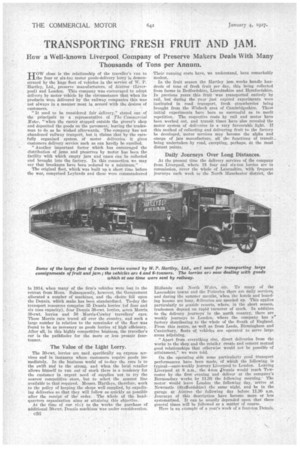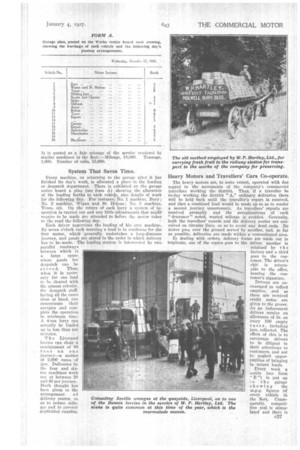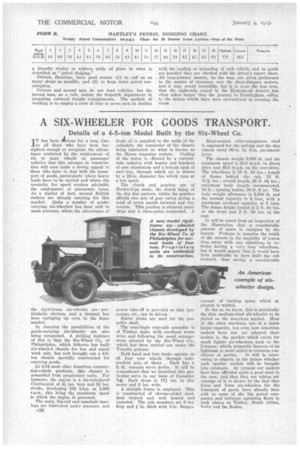TRANSPORTING FRESH FRUIT AND JAM.
Page 58

Page 59

Page 60

If you've noticed an error in this article please click here to report it so we can fix it.
How a Well-known Liverpool Company of Preserve Makers Deals With Many Thousands of Tons per Annum.
-Er OW close is the relationship of the traveller's van to _Lithe four or six-toa motor goods-delivery lorry is demonstrated by the huge fleet of vehicles in the service of W. P. Hartley, Ltd., preserve manufacturers, of Aintree (Liverpool) and London. This company was encouraged to adopt delivery by motor vehicle by the circumstance that when its products were delivered by the railway companies this was not always in a manner most in accord with the desires of customers.
"It used to be considered fair delivery." stated one of the principals to a representative of The Commercial Motor, "when the carter stopped outside the grocer's shop and deposited the goods on the pavement, leaving the tradesman to do as he wished afterwards. The company has not abandoned railway tranport, but it claims that by the carefully organized system of motor deliveries it gives customers delivery service such as can hardly be excelled.
"Another important factor which has encouraged the distribution of jams and preserves by motor has been the facility with which empty jars and cases can be collected and brought into the factory. In this connection we may say that breakages have been reduced to a minimum."
The original fleet, which was built up a short time before the war, comprised Leylands and these were commandeered
In 1914, when many of the firm's vehicles were lost in the retreat from Mons. Subsequently, however, the Government allocated a number of machines, and the choice fell upon the Dennis, which make has been standardized. To-day the transport resources comprise 35 Dennis lorries (of four and six tons capacity), four Dennis 30-cwt. lorries, seven Morris 30-cwt. lorries and 50 Morris-Cowley travellers' cars. These Morris cars travel all over the country, and such a large number in relation to the remainder of the fleet was found to be as necessary as goods lorries of high efficiency. After all, in this highly competitive in:mimes, the traveller's car is the pathfinder for the more or less prosaic fourtonner.
The Value of the Light Lorry.
The 30-cwt. lorries are used specifically on express services and in instances where customers require goods immediately. In the business world of to-day the race is to the swift and to the strong, and when the local retailer allows himself to run out of stock there is a tendency for the customer in urgent need of supplies not to try the nearest competitive store, but to select the nearest line available to that required. Messrs. Hartley a, therefore, work to the policy of keeping the shops well supplied, by expediting deliveries so that they will follow as quickly as possible after the receipt of the order. The whole of the headquarters organization aims at attaining this objective.
At the time of our vi.-3:t to the works the purchase of additional 30-cwt. Dennis machines was under consideration. Their running costs have, we understand, been remarkably modest.
In the fruit season the Hartley jam works handle hundreds of tons of fresh fruit per day, this being collected from farms in Bedfordshire, Lincolnshire and Herefordshire. In previous years this fruit was transported entirely by rail, but during the year just expired experiments were instituted in road transport, fresh strawberries being brought from the Wisbech area of Cambridgeshire. These initial experiments have been so successful as to merit repetition. The respective costs by rail and motor have been worked out, and transit times have also revealed the motor system of deli7eries in a very favourable light. If this method of collecting and delivering fruit to the factory he developed, motor services may become the alpha and omega of jam manufacture, all the functions of transit. being undertaken by road, excepting, perhaps, at the most distant points.
Daily Journeys Over Long Distances.
At the present time the delivery services of the company from Liverpool, where 18 four and six-ton lorries are in commission, cover the whole of Lancashire, with frequent journeys each week to the North Manchester district, the
Midlands and North Wales, etc. To many of the Lancashire towns and the Potteries there are daily services, and during the summer mouths, when the hotels and boarding houses are busy, deliveries are speeded up. This applies particularly to seaside resorts, where, in the short season, tradesmen depend on rapid turnover of stock. In addition to the delivery journeys in the north country, there are weekly journeys to London, where the company has factory distributing to the whole of the South of England. From this centre, as well as from Leeds, Birmingham and Canterbury, fleets of vehicles are operated to serve large areas adjoining.
"Apart from everything else, direct deliveries from the works to the shop and the retailer create and cement mutual good relationships that otherwise would not be possible of attainment," we were told.
On the operating side some particularly good transport performances have been made, of which the following is typical—once-weekly journey Liverpool to London. Leaving Liverpool at 8 am., the 4-ton Pennis would reach Tow°ester by the first evening and deliver at the company's Bermondsey works by 11.30 the following morning. The motor would leave London the following day, arrive at Newcastle (Staffordshire) the same night, and be in the garage at Aintree the following day before 11.30 am. Journeys of this description have become more or less systematized. It can be usually depended upon that these general times will be followed as a matter of course.
Here is an example of a year's work of a four-ton Dennis.
It is quoted as a fair aierage of the service rendered by similar machines in the fleet:—Mileage, 18,000. Tonnage, 1,600. Number of calls, 15,900.
System That Saves Time.
Every machine, on returning to the garage after it has finished its day's work, is allocated a plave in the loading or despatch department. There is exhibited on the garage notice board a plan (see form A) showing the allocation of the loading berths to each vehicle, also details of work for the following day. For instance, No.' 1 machine, Bury ; • No. 2 ma:chine, Wigan and St. Helens; No. 3 machine, Town. ete. On the return of each lorry a system of inspection is carried out and any little adjustments that might require to be made are attended to before the motor takes to the road the-following day.
Each driver Supervises the loading of his own machine. .seven o'clock each morning a load is in readiness for the first motor, which 'generally undertakes a long-distance journey. and goods are stored in the Order in which delivery has to be. made. The loading station is intersected by two parallel roadways between which is a large space where goods for despatch can be st are d. Thus, when it is necessary for one load to be cleared with the utmost celerity. the despatch staff, baying all the cases close at band, can concentrate their energies and complete the operation in minimum time. A 4-ton lorry can actually be loaded up in less than ten minutes.
P Ii e Liverpool lorries can clear a consignment of 80 tons on one jo urney—a matter of 2,000 cases of jam. Deliveries by the four and sixton machines work out at between 20 awl 40 per journey. Much thought has been given to the
arrangement of delivery routes, so as to reduce mileage and to prevent duplicated running. The old method employed by W. P. Hartley, Ltd., for carrying fresh fruit to the railway station for transport to the works of the company for preserving.
Heavy Motors and Travellers' Cars Co-operate.
The heavy motors are, to some extent, operated with due regard to the movements of the company's commercial travellers working the distriet. Thus, if a traveller be to-day working the dictrict "A," ordinary deliveries there will he held back until the traveller's report is received, and then a combined load would be made up so as to render a second journey unnecessary. As travellers' reports are received promptly and the peregrinations of each " drummer" noted, wasted mileage is avoided. Generally, both the travellers' rounds and the delivery routes are conceived on circular lines, so as to avoid any dead ends. No motor goes over the ground served by another, and, so far as possible, deliveries are made within a concentrated area.
In dealing with orders, delivery forms are made out in triplicate, one of the copies goes to the driver, another is retained by the factory and a third goes to the customer. The driver's chit is returnable to the office, bearing the enstomer's signature.
Drivers are encouraged to collect empties, and as these are received credit notes are given to the grocer. As an inducement drivers receive an allowance of 3s. on every 100 empty cases, including jars, collected. The effect of this is to encourage drivers to be diligent in their attentions to customers, and not to neglect opportunities of bringing in return loads.
Every week a notice (see form " B ") is put up in the garage showing the m.p.g. figures !of
every vehicle in the fleet. Consequently, competitive zeal is stimulated and there is a friendly rivalry to achieve pride of place in what is described as " petrol dodging."
Drivers, therefore, have good reason (1) to call on as many shops as possible, and (2) to keep down petrol consumption.
Drivers and second men do not load vehicles, but the second man, as a rule, assists the despatch department in preparing outward freight consignraents. The method of working is to employ a crew of four to seven men in dealing
with the loading or unloading of each vehicle, and as -goods are handled they are checked with the driver's report sheet. All long-journey motors, . by the. way, are given .preference in the matter of clearance over the short-distance motors, and it may sound incredible, but it is none the less true, that the eight-mile, round in the Birkenhead district has often taken longer than the journey to Birmingham, °Wing to the delays which have neen encountered in crossing the Wen












































































































